Integration of Single-Photon Emitters in 2D Materials with Plasmonic Waveguides at Room Temperature
Abstract
1. Introduction
2. Materials and Methods
2.1. Sample Preparation
2.2. Numerical Simulations
2.3. Experimental Setup
3. Results
4. Conclusions
Author Contributions
Funding
Conflicts of Interest
References
- Aharonovich, I.; Englund, D.; Toth, M. Solid-State single-photon emitters. Nat. Photon. 2016, 10, 631–641. [Google Scholar] [CrossRef]
- Yonezu, Y.; Wakui, K.; Furusawa, K.; Takeoka, M.; Semba, K.; Aoki, T. Efficient single-photon coupling from a nitrogen-vacancy center embedded in a diamond nanowire utilizing an optical nanofiber. Sci. Rep. 2017, 7, 12985. [Google Scholar] [CrossRef] [PubMed]
- Chen, Y.T.; Nielsen, T.R.; Gregersen, N.; Lodahl, P.; Mørk, J. Finite-Element modeling of spontaneous emission of a quantum emitter at nanoscale proximity to plasmonic waveguides. Phys. Rev. B 2010, 81, 125431. [Google Scholar] [CrossRef]
- Schörner, C.; Adhikari, S.; Lippitz, M.A. Single-Crystalline silver plasmonic circuit for visible quantum emitters. Nano Lett. 2019, 19, 3238–3243. [Google Scholar] [CrossRef]
- Kim, S.; Duong, N.M.H.; Nguyen, M.; Lu, T.J.; Kianinia, M.; Mendelson, N.; Solntsev, A.; Bradac, C.; Englund, D.R.; Aharonovich, I. Integrated on chip platform with quantum emitters in layered materials. Adv. Opt. Mater. 2019, 7, 1901132. [Google Scholar] [CrossRef]
- Peyskens, F.; Chakraborty, C.; Muneeb, M.; Thourhout, D.V.; Englund, D. Integration of single photon emitters in 2D layered materials with a silicon nitride photonic chip. Nat. Commun. 2019, 10, 4435. [Google Scholar] [CrossRef]
- Siampour, H.; Kumar, S.; Bozhevolnyi, S.I. Nanofabrication of plasmonic circuits containing single photon sources. ACS Photon. 2017, 4, 1879–1884. [Google Scholar] [CrossRef]
- Huck, A.; Andersen, U.L. Coupling single emitters to quantum plasmonic circuits. Nanophotonics 2016, 5, 483–495. [Google Scholar] [CrossRef][Green Version]
- Marseglia, L.; Saha, K.; Ajoy, A.; Schröder, T.; Englund, D.; Jelezko, F.; Walsworth, R.; Pacheco, J.L.; Perry, D.L.; Bielejec, E.S.; et al. Bright nanowire single photon source based on SiV centers in diamond. Opt. Express 2018, 26, 80–89. [Google Scholar] [CrossRef]
- Akimov, A.V.; Mukherjee, A.; Yu, C.L.; Chang, D.E.; Zibrov, A.S.; Hemmer, P.R.; Park, H.; Lukin, M.D. Generation of single optical plasmons in metallic nanowires coupled to quantum dots. Nature 2007, 450, 402–406. [Google Scholar] [CrossRef]
- Kumar, S.; Bozhevolnyi, S.I. Excitation of hybrid plasmonic waveguide modes by colloidal quantum dots. ACS Photon. 2019, 6, 1587–1593. [Google Scholar] [CrossRef]
- De-Torres, J.; Ferrand, P.; des Francs, G.C.; Wenger, J. Coupling emitters and silver nanowires to achieve long-range plasmon-mediated fluorescence energy transfer. ACS Nano 2016, 10, 3968–3976. [Google Scholar] [CrossRef] [PubMed]
- Bermùdez-Ureña, E.; Gonzalez-Ballestero, C.; Geiselmann, M.; Marty, R.; Radko, L.P.; Holmgaard, T.; Alaverdyan, Y.; Moreno, E.; Garcìa-Vidal, F.J.; Bozhevolnyi, S.I.; et al. Coupling of individual quantum emitters to channel plasmons. Nat. Commun. 2015, 6, 7883. [Google Scholar] [CrossRef] [PubMed]
- Sadzak, N.; Hèritier, M.; Benson, O. Coupling a single nitrogen-vacancy center in nanodiamond to superparamagnetic nanoparticles. Sci. Rep. 2018, 8, 8430. [Google Scholar] [CrossRef] [PubMed]
- Schell, A.W.; Kewes, G.; Hanke, T.; Leitenstorfer, A.; Bratschitsch, R.; Benson, O.; Aichele, T. Single defect centers in diamond nanocrystals as quantum probes for plasmonic nanostructures. Opt. Express 2011, 8, 7914–7920. [Google Scholar] [CrossRef] [PubMed]
- Ratchford, D.; Shafiei, F.; Kim, S.; Gray, S.K.; Li, X. Manipulating coupling between a single semiconductor quantum dot and single gold nanoparticle. Nano Lett. 2011, 11, 1049–1054. [Google Scholar] [CrossRef] [PubMed]
- Nguyen, M.; Kim, S.; Tran, T.T.; Xu, Z.Q.; Kianinia, M.; Toth, M.; Aharonovich, I. Nanoassembly of quantum emitters in hexagonal boron nitride and gold nanospheres. Nanoscale 2018, 10, 2267–2274. [Google Scholar] [CrossRef]
- Siampour, H.; Kumar, S.; Davydov, V.A.; Kulikova, L.F.; Viatcheslav, N.A.; Bozhevolnyi, S.I. On-Chip excitation of single germanium vacancies in nanodiamonds embedded in plasmonic waveguides. Light Sci. Appl. 2018, 7, 61. [Google Scholar] [CrossRef]
- Gong, J.; Steinsultz, N.; Ouyang, M. Nanodiamond-Based nanostructures for coupling nitrogen-vacancy centres to metal nanoparticles and semiconductor quantum dots. Nat. Commun. 2016, 7, 11820. [Google Scholar] [CrossRef]
- Senellart, P.; Solomon, G.; White, A. High-Performance semiconductor quantum-dot single-photon sources. Nat. Nanotechol. 2017, 12, 1026–1039. [Google Scholar] [CrossRef]
- Tran, T.T.; Elbadawi, C.; Totonjian, D.; Lobo, C.J.; Grosso, G.; Moon, H.; Englund, E.R.; Ford, M.J.; Aharonovich, I.; Toth, M. Robust multicolor single photon emission from point defects in hexagonal boron nitride. ACS Nano 2016, 10, 7331–7338. [Google Scholar] [CrossRef] [PubMed]
- Ziegler, J.; Blaikie, A.; Fathalizadeh, A.; Miller, D.; Yasin, F.S.; Williams, K.; Mohrhardt, J.; McMorran, B.J.; Zettl, A.; Alemaán, B. Single-Photon emitters in boron nitride nanococoons. Nano Lett. 2018, 18, 2683–2688. [Google Scholar] [CrossRef] [PubMed]
- Tran, T.T.; Bray, K.; Ford, M.J.; Toth, M.; Aharonovich, I. Quantum emission from hexagonal boron nitride monolayers. Nat. Nanotechnol. 2016, 11, 37–41. [Google Scholar] [CrossRef] [PubMed]
- Grosso, G.; Moon, H.; Lienhard, B.; Ali, S.; Efetov, D.K.; Furchi, M.M.; Jarillo-Herrero, P.; Ford, M.J.; Aharonovich, I.; Englund, D. Tunable and high-purity room temperature single-photon emission from atomic defects in hexagonal boron nitride. Nat. Commun. 2017, 8, 705. [Google Scholar] [CrossRef] [PubMed]
- Gottscholl, A.; Kianinia, M.; Soltamov, V.; Orlinskii, S.; Mamin, G.; Bradac, C.; Kasper, C.; Krambrock, K.; Sperlich, A.; Toth, M.; et al. Initialization and read-out of intrinsic spin defects in a van der Waals crystal at room temperature. Nat. Mater. 2020, 19, 540–545. [Google Scholar] [CrossRef]
- Kim, J.Y.; Song, J.H.; Jeong, K.Y.; Ee, H.S.; Seo, M.K. Full three-dimensional power flow analysis of single-emitter-plasmonic-nanoantenna system. Opt. Express 2015, 23, 11080–11091. [Google Scholar] [CrossRef]
- Huang, K.C.Y.; Jun, Y.C.; Seo, M.K.; Brongersma, M.L. Power flow from a dipole emitter near an optical antenna. Opt. Express 2011, 19, 19084–19092. [Google Scholar] [CrossRef]
- Ditlbacher, H.; Hohenau, A.; Wagner, D.; Kreibig, U.; Rogers, M.; Hofer, F.; Aussenegg, F.R.; Krenn, J.R. Silver nanowires as surface plasmon resonators. Phys. Rev. Lett. 2005, 95, 257403. [Google Scholar] [CrossRef]
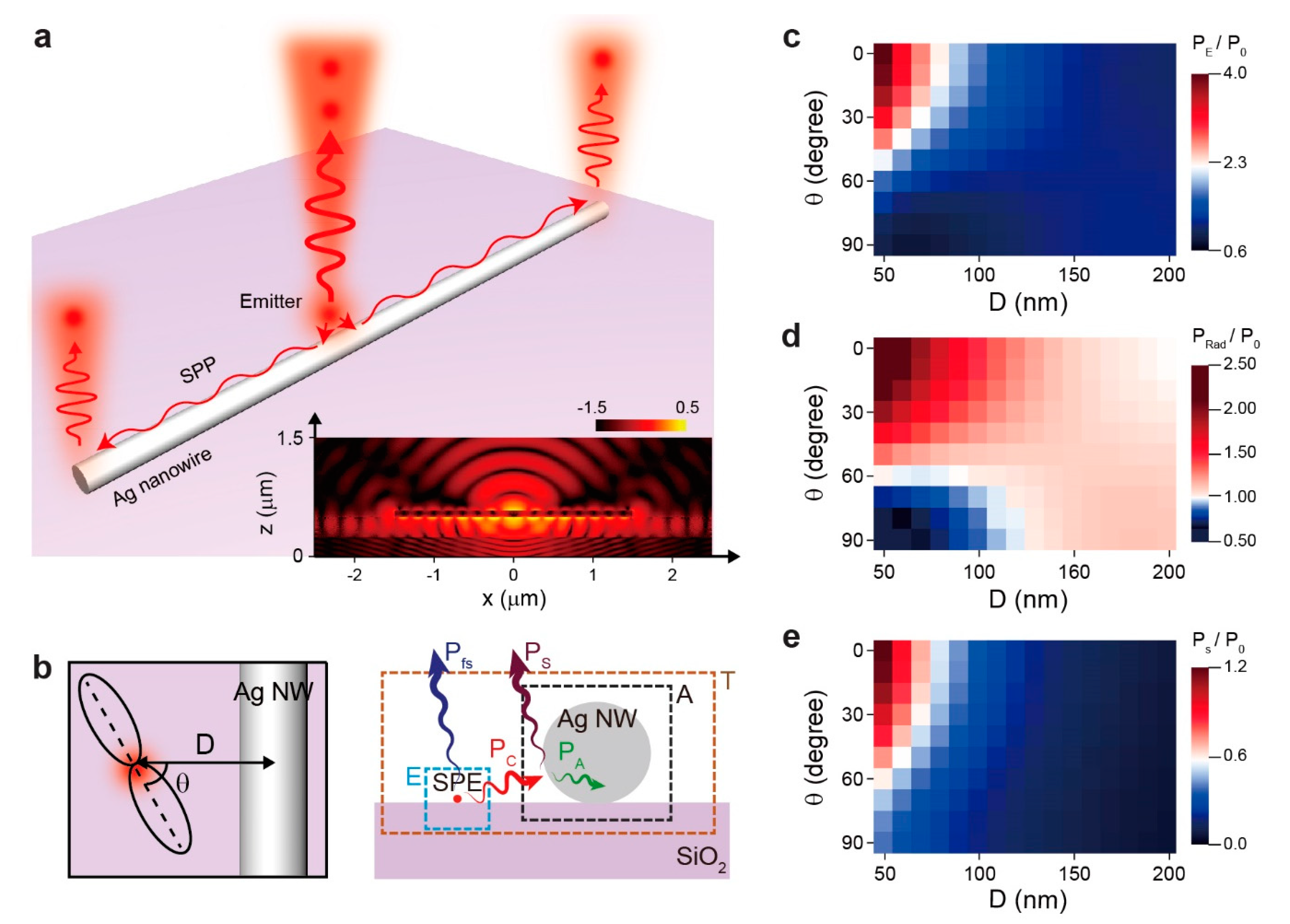
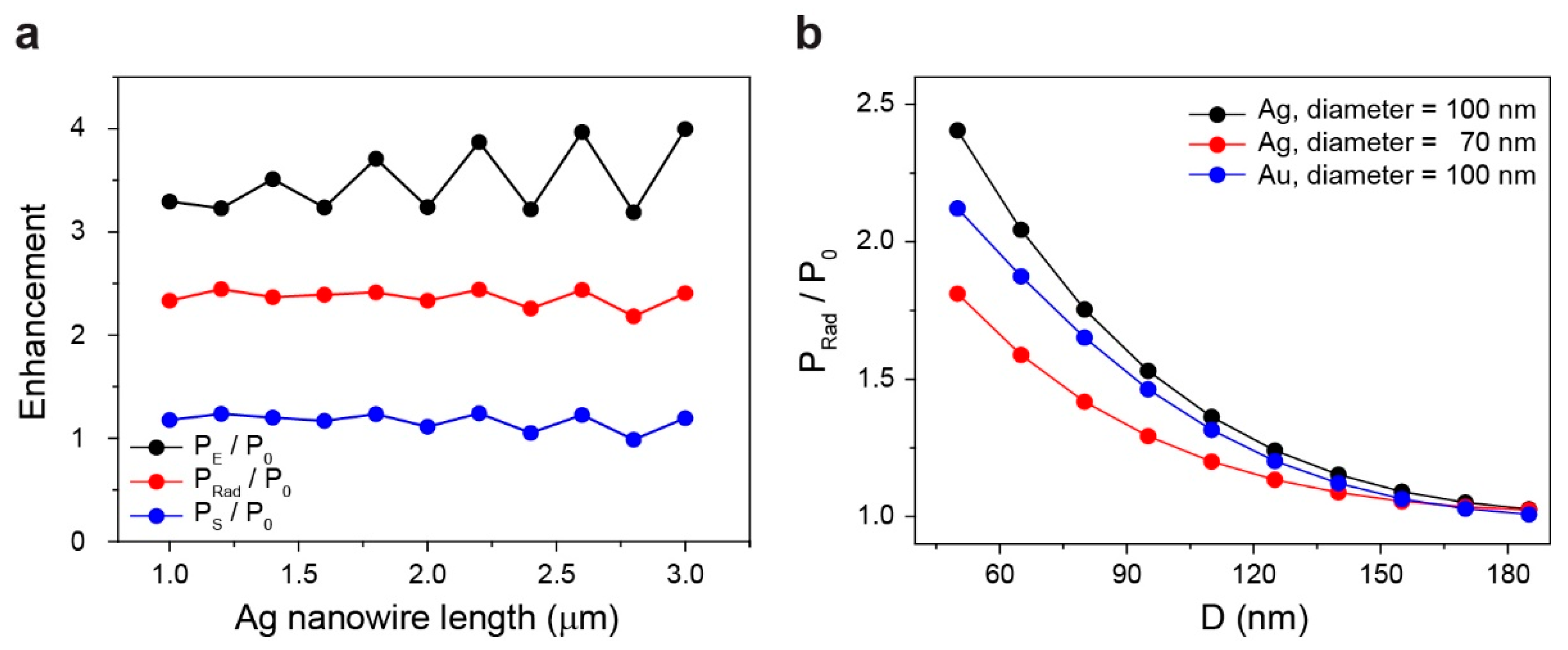
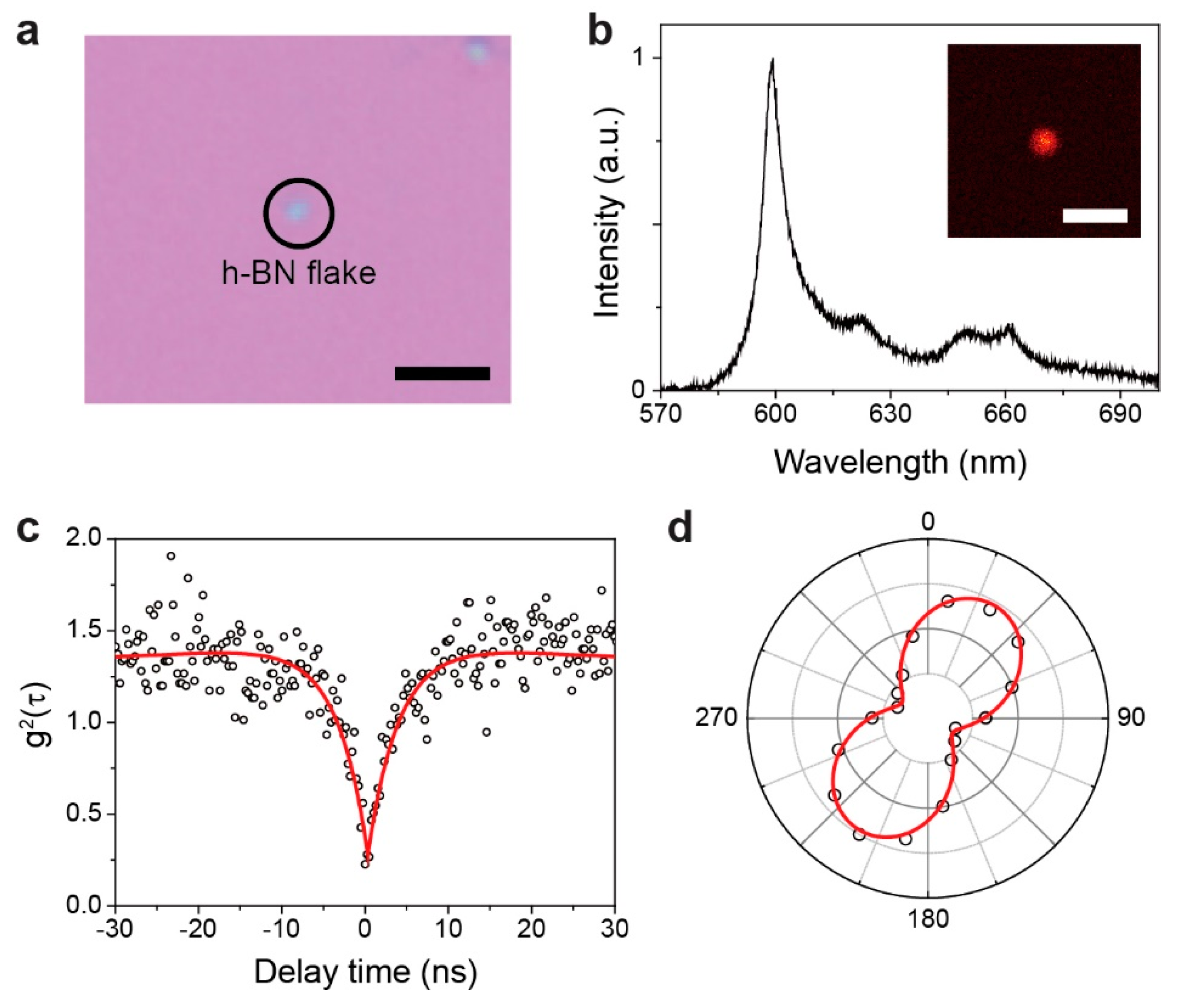
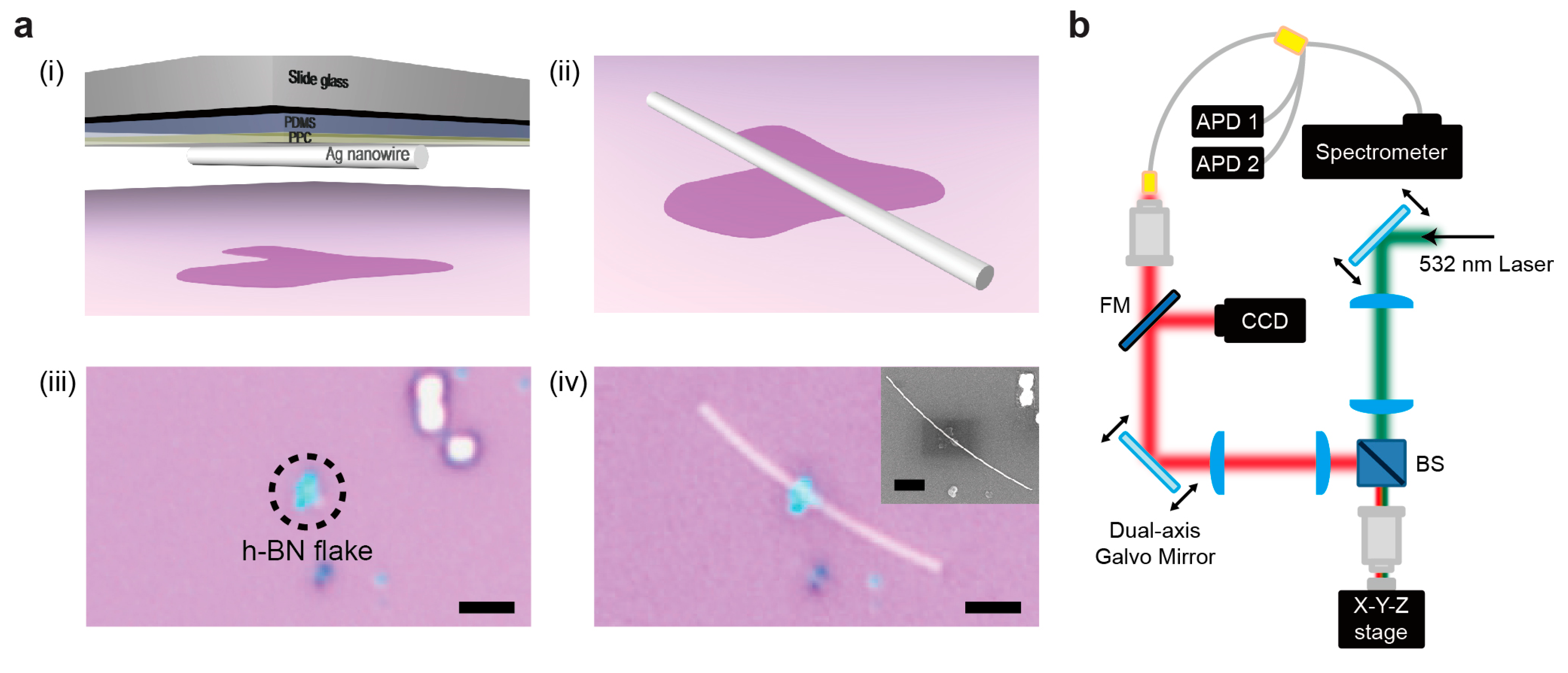
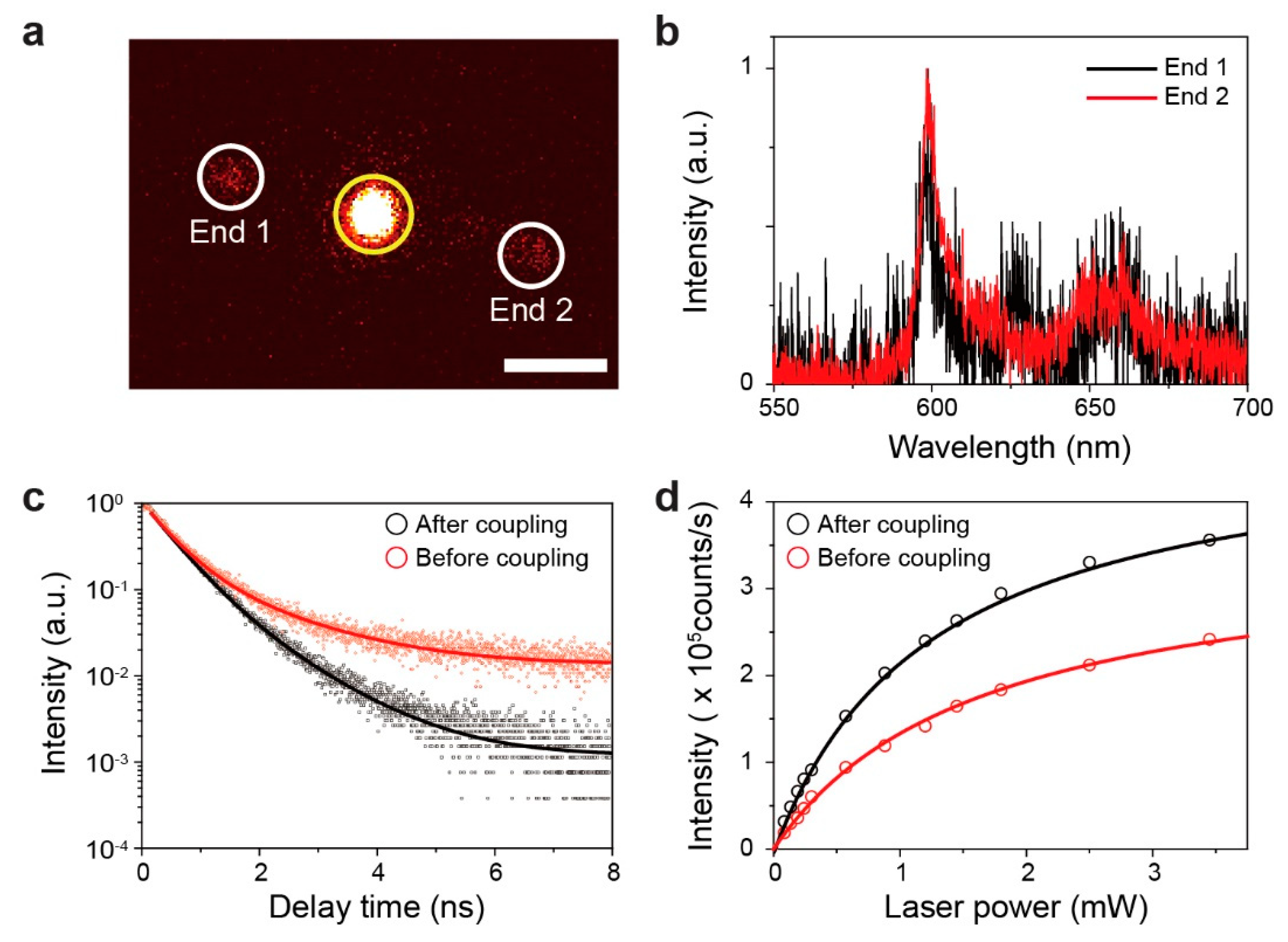
© 2020 by the authors. Licensee MDPI, Basel, Switzerland. This article is an open access article distributed under the terms and conditions of the Creative Commons Attribution (CC BY) license (http://creativecommons.org/licenses/by/4.0/).
Share and Cite
Jeong, K.-Y.; Lee, S.W.; Choi, J.-H.; So, J.-P.; Park, H.-G. Integration of Single-Photon Emitters in 2D Materials with Plasmonic Waveguides at Room Temperature. Nanomaterials 2020, 10, 1663. https://doi.org/10.3390/nano10091663
Jeong K-Y, Lee SW, Choi J-H, So J-P, Park H-G. Integration of Single-Photon Emitters in 2D Materials with Plasmonic Waveguides at Room Temperature. Nanomaterials. 2020; 10(9):1663. https://doi.org/10.3390/nano10091663
Chicago/Turabian StyleJeong, Kwang-Yong, Seong Won Lee, Jae-Hyuck Choi, Jae-Pil So, and Hong-Gyu Park. 2020. "Integration of Single-Photon Emitters in 2D Materials with Plasmonic Waveguides at Room Temperature" Nanomaterials 10, no. 9: 1663. https://doi.org/10.3390/nano10091663
APA StyleJeong, K.-Y., Lee, S. W., Choi, J.-H., So, J.-P., & Park, H.-G. (2020). Integration of Single-Photon Emitters in 2D Materials with Plasmonic Waveguides at Room Temperature. Nanomaterials, 10(9), 1663. https://doi.org/10.3390/nano10091663





